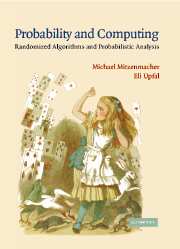Book contents
- Frontmatter
- Contents
- Preface
- 1 Events and Probability
- 2 Discrete Random Variables and Expectation
- 3 Moments and Deviations
- 4 Chernoff Bounds
- 5 Balls, Bins, and Random Graphs
- 6 The Probabilistic Method
- 7 Markov Chains and Random Walks
- 8 Continuous Distributions and the Poisson Process
- 9 Entropy, Randomness, and Information
- 10 The Monte Carlo Method
- 11 Coupling of Markov Chains
- 12 Martingales
- 13 Pairwise Independence and Universal Hash Functions
- 14 Balanced Allocations
- Further Reading
- Index
6 - The Probabilistic Method
- Frontmatter
- Contents
- Preface
- 1 Events and Probability
- 2 Discrete Random Variables and Expectation
- 3 Moments and Deviations
- 4 Chernoff Bounds
- 5 Balls, Bins, and Random Graphs
- 6 The Probabilistic Method
- 7 Markov Chains and Random Walks
- 8 Continuous Distributions and the Poisson Process
- 9 Entropy, Randomness, and Information
- 10 The Monte Carlo Method
- 11 Coupling of Markov Chains
- 12 Martingales
- 13 Pairwise Independence and Universal Hash Functions
- 14 Balanced Allocations
- Further Reading
- Index
Summary
The probabilistic method is a way of proving the existence of objects. The underlying principle is simple: to prove the existence of an object with certain properties, we demonstrate a sample space of objects in which the probability is positive that a randomly selected object has the required properties. If the probability of selecting an object with the required properties is positive, then the sample space must contain such an object, and therefore such an object exists. For example, if there is a positive probability of winning a million-dollar prize in a raffle, then there must be at least one raffle ticket that wins that prize.
Although the basic principle of the probabilistic method is simple, its application to specific problems often involves sophisticated combinatorial arguments. In this chapter we study a number of techniques for constructing proofs based on the probabilistic method, starting with simple counting and averaging arguments and then introducing two more advanced tools, the Lovasz local lemma and the second moment method.
In the context of algorithms we are generally interested in explicit constructions of objects, not merely in proofs of existence. In many cases the proofs of existence obtained by the probabilistic method can be converted into efficient randomized construction algorithms. In some cases, these proofs can be converted into efficient deterministic construction algorithms; this process is called derandomization, since it converts a probabilistic argument into a deterministic one.
- Type
- Chapter
- Information
- Probability and ComputingRandomized Algorithms and Probabilistic Analysis, pp. 126 - 152Publisher: Cambridge University PressPrint publication year: 2005

